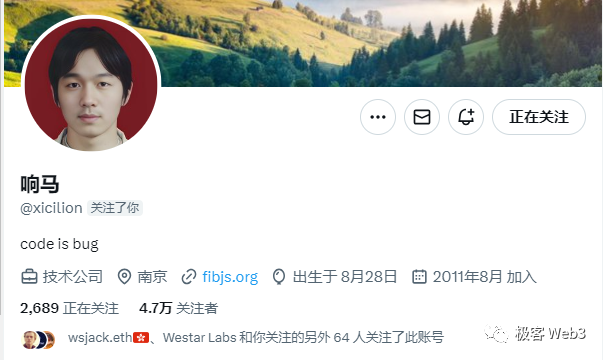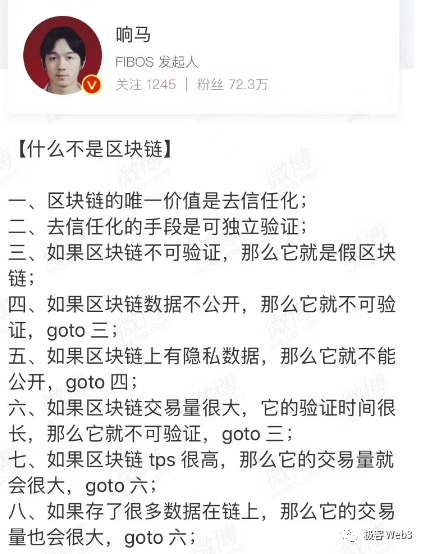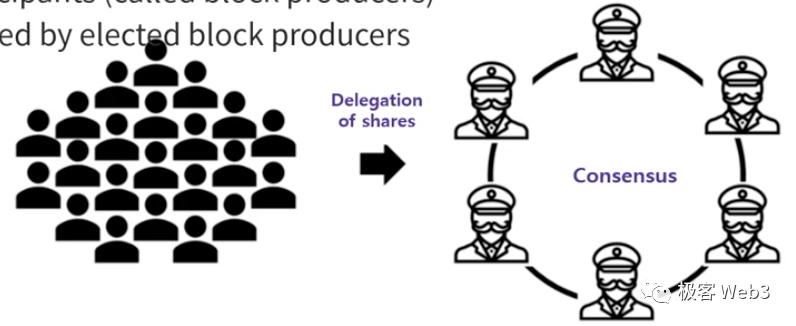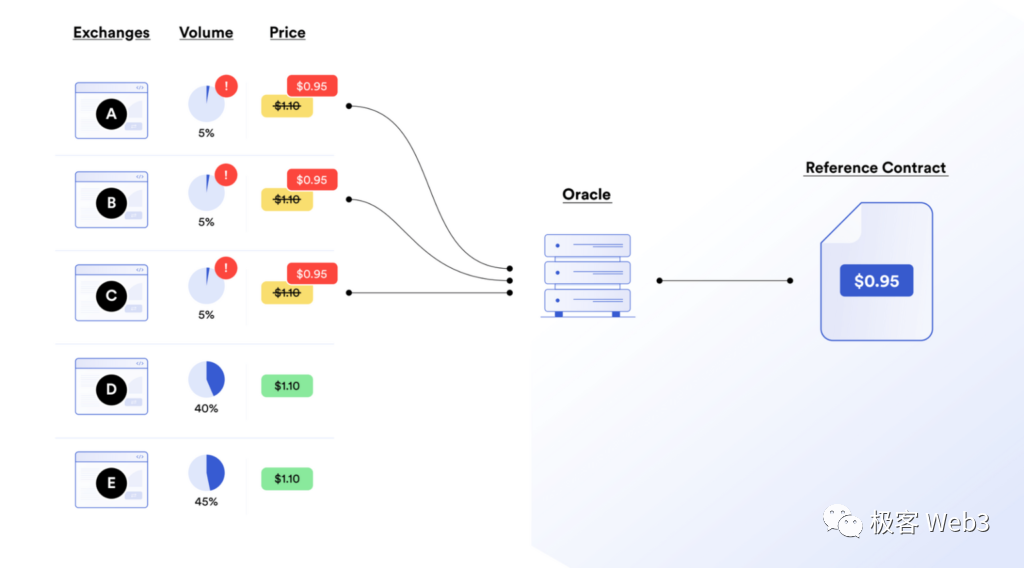Cryptocurrency celebrity Xiang Ma Pursuing high TPS in public chains is meaningless, DID + verifiable credentials may be the future new direction.
Cryptocurrency celebrity Xiang Ma believes that pursuing high TPS in public chains is pointless, and suggests that the future may be focused on DID + verifiable credentials.Written by: cynic, GeekWeb3 contributor
Interviewee: Xiangma, founder of FIBJS
Editor: Faust, co-founder of GeekWeb3

- Exploring the Future of Web3 Social (Part 2) Solving User Identity Issues with Proof-of-Personhood and Cryptographic Techniques
- The Engine Driving the Bitcoin Bull Market Grayscale Lawsuit, Ethereum Futures ETF, and Bitcoin Spot ETF.
- Bankless Podcast Selection Exploring the SET Evaluation Framework for Blockchain Systems Which is More Important, the Technical Layer, the Ecological Layer, or the Social Layer?
Introduction: Xiangma, founder of the FIBJS project, has been engaged in software development since 1992, with 30 years of experience. Xiangma first encountered internet-related technologies in 1994 and founded the first large-scale comprehensive community website in the Chinese-speaking world, Xici Hutong, in 1998. In 2012, he founded the Baozi Community and entered the EOS ecosystem in 2018. He is currently focused on the development of underlying infrastructure for fibjs and EOS.

This interview starts with Xiangma’s memories of EOS and extends to the political philosophy behind blockchain. He believes that:
- Pursuing extreme TPS is a pseudo blockchain, and high performance is actually the least important aspect;
- The core of POS is how to select elders, and its nature tends towards consortium chains. EOS, on the other hand, allocates block production rights through governance, which involves the source of public governance rights;
- The equity system of POS chains involves exploitation, where native token holders have governance rights while those who hold other assets do not. This problem is caused by the introduction of smart contracts. Smart contract blockchains led by Ethereum have transitioned from protecting private rights to managing public assets, giving rise to a series of complex and difficult-to-solve problems, such as top-heavy assets;
- Ethereum, which supports smart contracts and DeFi, governs public assets, but the distribution of related powers is unclear and unreasonable, such as why certain oracle systems are adopted and trusted in lending protocols. The deployment and adoption of permissionless contracts grant many individuals unsupervised powers, leading to a series of issues;
- Users are not concerned about underlying technologies. What they often want is simple and user-friendly products, rather than the most perfect ones;
- At present, Ethereum is actually a centralized trust center formed by decentralized technologies;
- DID+Verifiable Credentials may be a future direction. It can connect decentralized networks without the need for trust and boundaries;
- As long as there is a chain, there is consensus; with consensus, there are boundaries; with boundaries, it is impossible to achieve interoperability. What we need to do is to create a protocol without boundaries and trust, which is the attribute of the next generation of the internet.

Full Interview
1. Cynic: Let’s start this discussion about EOS and new public chains with a question. We all know that EOS was extremely popular in 2018, with its ICO raising a staggering $4.2 billion, shocking the blockchain and even the traditional financial industry, and making countless listed companies pale in comparison. However, today, four years later, the EOS ecosystem has declined significantly, with a 98% decrease in market value, and is gradually being forgotten by the world.
Here, can you briefly describe your memories and ups and downs of EOS based on your memory of the “Summer of 2018”?

Echo: My experience represents the experience of many people who entered the blockchain from the traditional technology circle. At that time, we were always “educated” that BTC was slow and expensive to use, but its price was soaring. At this time, we wanted to make the blockchain capable of carrying a wider range of businesses and a larger market, which obviously required higher throughput of the blockchain.
EOS proposed the astonishing indicator of 1 million TPS per second in such an era. Although now everyone knows that EOS cannot achieve this on a single chain alone, at that time, it gave everyone room for imagination. Did EOS really solve the efficiency problem of the blockchain? Can the blockchain become faster, accommodate more business, and create a larger market?
In terms of single-chain ecology, EOS actually performed well for a period of time. From a performance perspective alone, after our optimization, it can reach 30,000 TPS. EOS was actually a good project in terms of both performance and ecology. But I believe that the core of the blockchain is not performance, and EOS focuses too much on transaction processing speed and throughput. My view on high-performance blockchains began to change around 2019.
2. Cynic: I remember you said before, “EOS blocked the path of high-performance public chains in half a year.” Is this the change of thought you mentioned?
Echo: What is the process of this change? The development of EOS allowed us to discover problems in technical practice. We can compare it with other chains, such as BTC. Until now, the data scale of BTC has been relatively stable, and we can even verify historical data in a few hours. But for EOS, even if we only synchronize the historical data from 2018 to the end of 2019, we will feel the long synchronization time when running a full node. This actually goes against the purpose of blockchain and cryptography: Don’t trust, verify. In other words, verify the data yourself without trusting others. But the long synchronization time for historical data raises the threshold for running a full node, which means that you cannot complete the process of verifying transactions quickly, and most users can only trust the validation results of third-party nodes in the long run.

(Comment by Gavin Wood after the first downtime of Solana, pointing out that the true essence of blockchain is for users to run full nodes with low thresholds)
We found that in more and more blockchain projects, users can only rely on cloud service providers to verify blockchain ledger data.
At this point, we need to reflect on what is the essence of blockchain? What kind of businesses should use blockchain, and what kind of businesses should not? Should we sacrifice security for TPS? Should we sacrifice verifiability for high performance? When we lose the verifiability of data and assets, what is the difference between blockchain and Alipay? Why should I use blockchain instead of Alipay?
Later, I realized that those pursuing extreme TPS are pseudo-blockchains. Blockchain should find a balance between efficiency and security, and high performance is actually the least important aspect of blockchain.
3.Cynic: EOS founder BM has previously created two chains, both of which use DPOS consensus. What is your view on DPOS and its underlying philosophy? Because of the “D” in DPOS: Delegate mechanism, it seems that EOS naturally possesses on-chain governance capabilities.

响马: In my definition, there are only two types of consensus mechanisms, either POS or POW. POW is derived from computational power, while POS is derived from equity. POW is more permissionless, while the core of POS is how to select elders, essentially leaning towards consortium chains.
As public chains in the POS system, Ethereum simply uses staking and randomly selects consensus nodes to minimize subjective intervention. EOS, on the other hand, considers more about allocating block-producing rights through public governance.
However, POS always raises the question: What is the source of public governance rights? In POS, tokens are the source of this power, and everyone determines their individual governance rights through the amount of tokens staked, which is the equity system. This is different from national governance, where the power of the government comes from the transfer of human rights, adopting the human rights system.
The equity system has the problem of exploitation, where native token holders have governance rights, but those who hold other on-chain assets do not. This is a huge problem brought about by the introduction of smart contracts. Smart contract blockchains led by Ethereum, from protecting private rights to managing public assets, will inevitably encounter more problems.

4.Cynic: When you mentioned “the introduction of smart contracts brought about significant problems,” what did you mean?
响马: To put it this way, Bitcoin is just a ledger without smart contracts, which makes Bitcoin only a tool for accounting, only recording the transfer of private property, and only involving private rights. This is relatively simple, and the power model is reasonable; but after Ethereum introduced smart contracts, it fundamentally became a decentralized cloud service.
Ethereum, which supports smart contracts, actually governs public assets, no longer just private property like Bitcoin, which has led to a series of extremely complex, ambiguous, and difficult-to-solve problems.
First of all, on the Ethereum blockchain, there are native assets ETH and other circulating assets (or parasitic assets). “Parasitic assets” only have the right to use without governance rights over the underlying chain. As the number of circulating “parasitic assets” on the chain increases, Ethereum inevitably experiences the phenomenon of “top-heavy”, that is, the mismatch between the massive assets on the underlying security and the upper-layer carrying capacity. After the transition from PoW to PoS, this top-heavy problem becomes more apparent, and the governance rights of the entire system become more centralized;
More importantly, smart contracts give Ethereum public asset management attributes. Various DeFi-related transactions involving the redistribution of rights related to public assets can be extended to governance rights. For example:
A certain DeFi lending protocol adopts a consortium of oracle nodes to provide price feeding services and determine which users’ collateralization ratios are insufficient and need liquidation. This actually gives oracle nodes the right to manage public assets; but why should we trust these oracles and give them public power? Many times, there is no room for user participation, and power is given to individuals who are not sufficiently supervised and disclosed. Considering the frequent occurrence of oracle price manipulation attacks in the past, this problem is quite serious. Unsupervised and unauthorized power is often untrustworthy.

Whenever it involves the management of public asset rights, it actually requires sufficient supervision and disclosure, but there is currently no mechanism to fully regulate various smart contract projects.
In the final analysis, I believe that permissionless should only apply to private rights, not public rights. The deployment and adoption of permissionless contracts grant many individuals with unsupervised power, which leads to a series of problems. The example of Multichain cross-chain bridges may be more intuitive.
The governance power distribution ideas and sources related to EOS are relatively clear, but the sources of power distribution for DeFi protocols and other smart contract projects are unclear, or even disappeared. If we establish clear and open governance like EOS, and allocate public power in a clear and reasonable manner, it will make the development of the project itself more difficult and heavy. This is a difficulty.
Therefore, whenever it involves the management of public assets, it involves the issue of power boundaries. For example, Germans cannot let the French manage their affairs. The introduction of smart contracts means that Ethereum actually governs public assets, no longer simply private property like Bitcoin, which leads to a series of extremely complex, ambiguous, and difficult-to-solve problems.
5. Cynic: EOS proposes a unique resource model that imitates the allocation of computer network resources such as bandwidth NET, computing power CPU, and memory RAM. What impact do you think this design has on EOS?
Xiangma: The banking ledger model used by BTC and Ethereum has a relatively simple operating mechanism, making it more popular, but it also faces the problem of state bloat (state explosion). In the design of EOS, if storage space is occupied, it will continue to consume resources (similar to gas). This design can avoid state bloat, and the design of simulating computer resource charging makes it more similar to the experience of cloud services.
Although the resource model may be more reasonable for service providers, the complex design exceeds the understanding ability of most users and is not easy to accept. Users are not concerned about the underlying technology. What they want is often a simple and easy-to-use product, rather than the most perfect one.
6. Cynic: EOS plans to switch to the HotStuff consensus. What do you think is the purpose of this change? (Note: HotStuff is a pipelined implementation of PBFT, where each block completes a round of 2/3 majority confirmation by block-producing nodes before producing the next block)
Xiangma: EOS’s previous design did not pursue instant transaction finality and took 3 minutes to finalize a transaction. (Note: In order to speed up the block production and reduce the complexity of information transmission between nodes, EOS does not need to wait for 2/3 of the people to confirm before producing the next block, and the receiver does not immediately broadcast their confirmation result. These extend the final confirmation time of a block. After a new block is generated, it takes another 355 blocks to be finalized).
The modification of the consensus algorithm in EOS is to improve transaction finality. This change has limited impact on the entire project because the basic architecture remains unchanged and does not fundamentally affect block production. It can be seen as an extension of the transaction finality feature based on DPOS using HotStuff.
7. Cynic: Can you introduce the EOS-related technical work you are currently working on?
Xiangma: We have implemented the EVM smart contract on EOS and have modified the cross-chain functionality. The official EVM implementation of EOS is implemented on the WASM virtual machine, which is not only slow but also cannot reuse the original infrastructure.
The design of EOS’s RPC (Remote Procedure Call) also has flaws. Writing RPC involves encapsulating Ethereum transactions and submitting them to EOS. For reading RPC, in order to achieve convenience, EOS.evm data is directly synchronized to an independent Ethereum node. The architecture is too complex, and there are hardly any people who can provide API services. Only the project party itself supports it.
Our EVM is natively implemented, and nodes can directly call EOS assets. It is compatible with development tools such as web3.js and ethers.js, providing a user experience similar to Ethereum. Our modified project will be gradually open-sourced.
8. Cynic: You have also experienced the whole process of a mainstream narrative from its inception to its explosion and then to its silence. From your perspective, where will the entire industry go in the future?
Xiangma: I have always said that web3.0 and web3 are not the same thing. Web3.0 is the sum of the problems that the next generation of the Internet wants to solve, while web3 is an attempt by a group of people to use blockchain to solve all the problems of the Internet.
However, the real problem that the Internet is facing now is actually a problem with the trust mechanism of the old Internet. Because in the original Internet, everyone cannot get rid of the assumption of trust in the central server, which leads to all users being hijacked by central institutions.
Is there a way to turn the Internet back into a trustless distributed network? This is the key, rather than reestablishing trust in a centralized network formed by decentralized technologies. Currently, Ethereum is actually a centralized trust center formed by decentralized technologies.
IPFS is also a similar example. In the past, we said that data is stored in central institutions and our data is hijacked. To solve this problem, we need to decentralize data storage. But now we see that IPFS is not a decentralized storage, it is just a centralized storage formed by decentralized technologies, it is still a service, as long as it is a service, it is centralized.
We need to return to the essence of the Internet, rather than trust in a new (decentralized technology-based) centralized network. DID+Verifiable Credentials may be a future direction, it can connect decentralized networks without trust and boundaries.
DID itself is not an identity, but an identity protocol. There is no mechanism in DID that everyone must agree on. I can generate a public key myself, and then DID exists, without the need for others’ recognition. How do we use DID to solve practical problems? Through verifiable credentials.
One of the most important breakthroughs is that it is no longer data sharing between two institutions, but information sharing led by information subjects. At this point, you will find that although it does not have consensus, the so-called concept of decentralization, or blockchain, you will find that it is very decentralized, with only three participants: the controller of the information, the recipient of the information, and the information subject.
When we initially designed this protocol, it was also based on a chain. Later, we were repeatedly asked: Who built the chain? Can you say that the construction of this chain can be recognized by everyone? As long as there is a chain, there is consensus, with consensus, there are boundaries, and with boundaries, interoperability cannot be achieved.What we need to do is a protocol without boundaries and without trust, which is the attribute of the next generation of the Internet.
We will continue to update Blocking; if you have any questions or suggestions, please contact us!
Was this article helpful?
93 out of 132 found this helpful
Related articles
- Disassembling Rollup Economics Business Models, Interoperability, and Layer 3
- Opinion The market’s focus is no longer simply on proving the superiority or inferiority of technology.
- LD Capital Puffer – Secure Signer technology empowerment, LSD track dark horse
- Key Factors for CHEX’s Success Mobile Native Embedded Technology Improving Trading Experience
- W Labs Why are all Web3 models Ponzi schemes?
- Vitalik on AI Will not replace humans, we will eventually adapt to the new technological wave
- Can you make payments by talking to AI? The Reserve Bank of India explores innovative instant payment technology.
